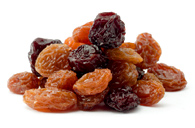We had Chelsea buns for tea yesterday. While discussing its ingredients (and its curious name), my American-raised daughter asked slightly suspiciously, “What’s a sultana?” Good question. Even though I know what it looks and tastes like, I realized I had no idea what it actually is, or what makes it different from a raisin. (And if you’re wondering what a Chelsea bun is, keep reading …)
The sultana is a “white” (pale green) variety of seedless grape, also called a sultanina, a Thompson Seedless (in the U.S.), a Lady de Coverly (in England), and a Kishmish (in Turkey and Palestine). The sultana grape is nicknamed the “three-way grape” since it’s used for table grapes, raisins and wine. Because of its multi-functionality, it’s the most planted grape in California. It’s thought to have originated from either Constantinople or from the Asian part of the Ottoman Empire, from where the sultana raisin was originally and traditionally exported to the English-speaking world, some time in the 17th and 18th centuries. In some countries, namely Great Britain, Ireland, New Zealand, Australia and Canada, sultana is also the name of that particular type of raisin; in fact, in the UK, sultana usually refers to the dried fruit — which is basically a golden, plumper, rounder, more juicy version of the raisin (it’s treated with sulfur dioxide to maintain its color) — rather than to the variety of grape from which it’s made. However, in the U.S., raisin is a catch-all word for all dried grapes, making the word sultana unfamiliar to speakers of American English.
Another variety of raisin is the currant, made from the small, dried Black Corinth seedless grape, which is produced mainly in California and the Levant.* Currants — not to be confused with the berries called redcurrants or blackcurrants — are miniature raisins that are firm, dark in color and have a tart, tangy flavor; they are more often found in cooking and baking than their sweeter raisin cousins, which enjoy strutting their stuff as healthy snacks these days. The currant gets its name from Corinth, the port in Greece from which it originated.
For a comprehensive history of the raisin — and other dried fruits — check out the second chapter of Sun-maid’s rather delightful 100th anniversary book.
And back to the Chelsea bun: This classy-sounding treat is a type of currant bun — made of a rich yeast dough sweetened with brown sugar, cinnamon and spice mixtures, spread with butter, and rolled up with currants, lemon peel and dried fruits before being baked. (Americans: think cinnamon roll or cinnamon swirl, with less sugar and lots of raisins.) It was so named after the Bun House in Chelsea, a fashionable area of London, where the bun was first created in the 18th century. Favored and frequented by the British royalty of the time, the Bun House was demolished in 1839.
Are you now craving a Chelsea bun? Well, don’t fret: Fitzbillies, Cambridge’s oldest craft bakery and a veritable institution, is famous for its Chelsea buns and traditional cakes. And it ships all over the world. As it boasts on its website: “Our extra sticky Chelsea buns travel well – Sir Edmund Hillary took a box with him to Base Camp when he conquered Everest. They are packed in an airtight cellophane envelope and then into a stout corrugated mailing box. They should reach you in perfect condition for the final assault on the summit… or indeed your tea.”
Go scoff a Chelsea bun today.
* The Levant is “the crossroads of western Asia, the eastern Mediterranean, and northeast Africa”.

